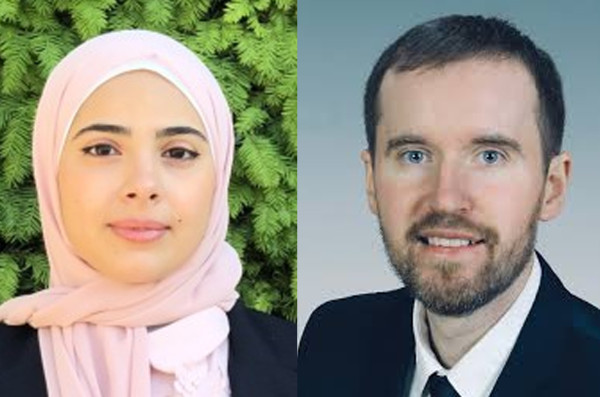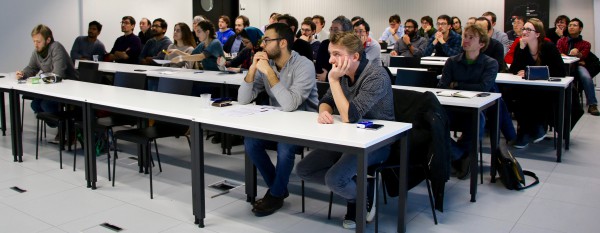MARVEL Junior Seminar — November 2023

Each seminar consists of two presentations of 25 minutes each, allowing to present on a scientific question in depth, followed by time for discussion. The discussion is facilitated and timed by the chair.
Note that starting this month, we are changing the format slightly, as the pizzas will be served AFTER the seminars in order to facilitate discussions based on the talks just presented.
Onsite participation
12:15 — Seminars take place in EPFL room Coviz2 (MED 2 1124)
~13:15 — Pizzas will be served in the MED building atrium, second floor
Online participation
Starting at 12:15:
https://epfl.zoom.us/j/68368776745
Password: 1923

Abstracts
Talk 1 — Investigating the electrical properties of EuCd2X2
Serena Nasrallah
Dept. of Physics, University of Fribourg
Institute of Solid-State Physics, TU Wien (Austria)
EuCd2X2 (X= As, Sb, P) has a high density of magnetic moments, co-existing with a low concentration of itinerant carriers. Planes of Eu2+ atoms are separated by blocks of Cd2X2 which give rise to conduction and valence bands. Eu2+ atoms have large magnetic moments with J=7/2, and they sit on the corners of a triangular lattice. The Fermi surface of EuCd2As2 appears to depend strongly on how the samples are grown [1,2], with a delicate interplay of magnetism and the Fermi surface [2].
In the presentation, I will show optical measurements and magneto optical measurements of EuCd2As2 [3]. Same measurements on EuCdSb2 and EuCd2P2 will be showed to see how optical properties evolve when substituting As with Sb and P. This will give an idea about the energy gap of EuCd2X2 and its band structure. Magnetization data using Squid will give information about the magnetic structure of this material. While electrical transport data will give information about the resistivity and charge carriers and its relationship with magnetism.
[1] J.-Z. Ma et al, Science Advances 5 4718 (2019)
[2] Na Hyun Jo et al, Nature Communications 12 7169 (2021)
[3] D. Santos-Cottin et al, Physical Review letter 131, 186704 (2023)
Talk 2 — Pushing the frontiers of Hubbard functionals: recent developments and applications to Li-ion batteries
Iurii Timrov
Laboratory for Materials Simulations (LMS), Paul Scherrer Institut (PSI)
Density-functional theory (DFT) with extended Hubbard functionals is a powerful method for studying complex materials containing transition-metal and rare-earth elements, owing to its accuracy in correcting self-interactions and its low computational costs [1]. Recently, we developed an automated and reliable approach for the first-principles determination of the on-site U and inter-site V Hubbard parameters using density-functional perturbation theory [2-4].In this talk I will show the effectiveness of this computational framework for accurate and reliable study of Li-ion battery (LIB) cathode materials. In particular, I will show for phospho-olivine and spinel cathodes that DFT with extended Hubbard functionals correctly predicts the “digital” change in oxidation states of the transition-metal ions for the mixed-valence phases occurring at intermediate Li concentrations, leading to voltages in remarkable agreement with experiments [5,6]. I will show thus that the inclusion of intersite Hubbard interactions is essential for the accurate prediction of thermodynamic quantities when electronic localization occurs in the presence of inter-atomic orbital hybridization.
[1] V.L. Campo Jr and M. Cococcioni, J. Phys.: Condens. Matter. 22, 055602 (2010).
[2] I. Timrov, N. Marzari, M. Cococcioni, Phys. Rev. B 98, 085127 (2018).
[3] I. Timrov, N. Marzari, M. Cococcioni, Phys. Rev. B 103, 045141 (2021).
[4] I. Timrov, N. Marzari, M. Cococcioni, Comput. Phys. Commun. 279, 108455 (2022).
[5] I. Timrov, F. Aquilante, M. Cococcioni, N. Marzari, PRX Energy 1, 033003 (2022).
[6] I. Timrov, M. Kotiuga, N. Marzari, Phys. Chem. Chem. Phys. 25, 9061 (2023).
Check the list of the next MARVEL Junior Seminars here.
Low-volume newsletters, targeted to the scientific and industrial communities.
Subscribe to our newsletter